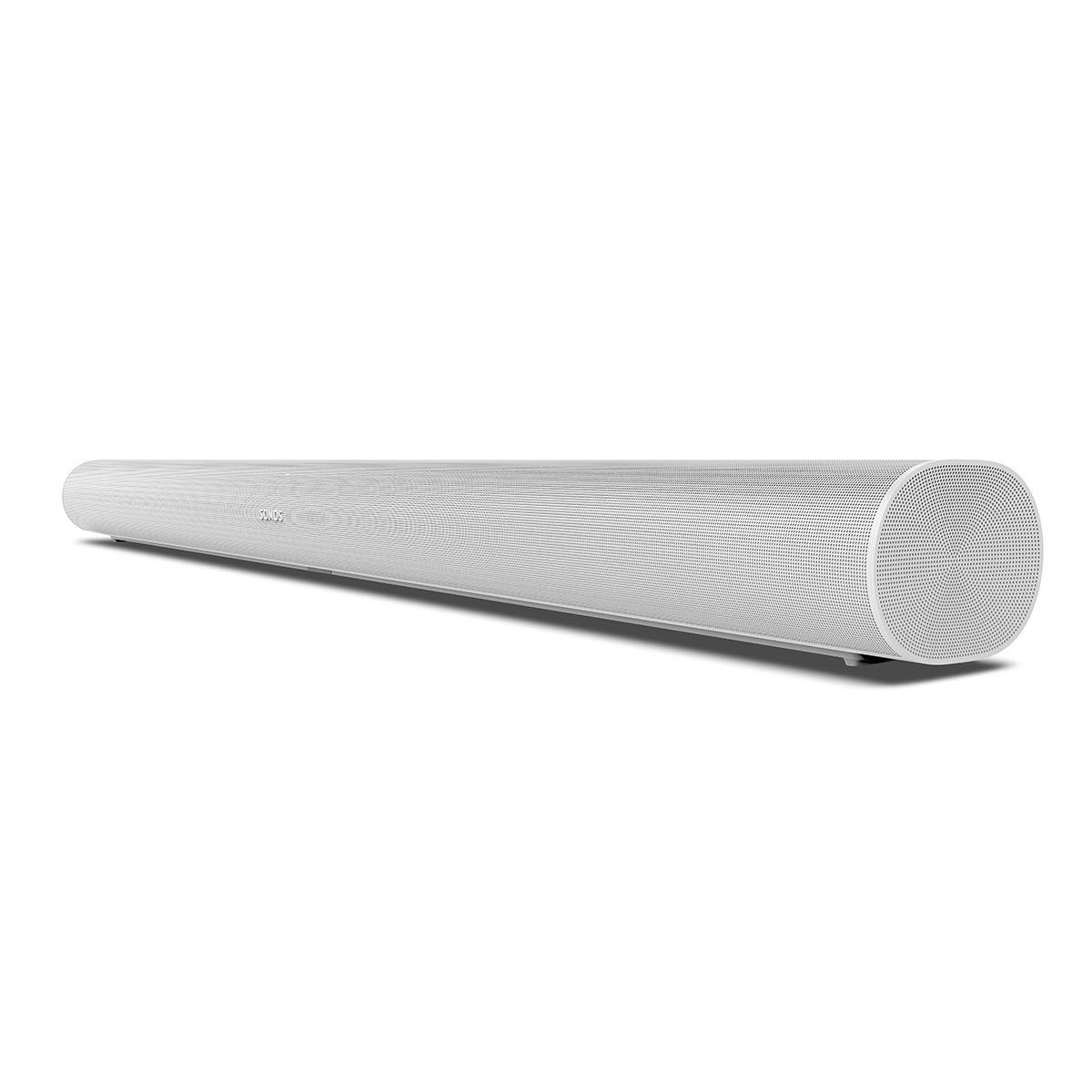
The search for better TV audio has led many consumers to soundbars that support Dolby Atmos, a technology that creates immersive 3D sound by precisely placing audio in a virtual sphere around you. Today, we're comparing two compelling options: the Sonos Arc ($564) and the Klipsch Flexus Core 200 ($499), which take different approaches to delivering theater-like sound.
When the Sonos Arc launched in 2020, it represented a significant leap forward in soundbar technology, introducing upward-firing speakers that bounce sound off your ceiling to create height effects. The newer Klipsch Flexus Core 200, released in 2023, builds on these advances while taking a more traditional approach to audio reproduction.
Both products reflect how far soundbar technology has progressed, moving from simple stereo enhancement to sophisticated multi-channel systems that can rival traditional home theater setups.

The Sonos Arc's 11-driver array delivers exceptionally balanced sound, with particular attention to vocal clarity and spatial precision. Its upward-firing speakers create a convincing height effect for Dolby Atmos content, though you'll need compatible content and a TV that supports Dolby Atmos through HDMI eARC to experience this.
The Klipsch Flexus takes a different approach, using fewer drivers but focusing on raw power and impact. Its dual 4-inch built-in subwoofers provide stronger bass response without requiring an external subwoofer, which is impressive for a standalone unit.
In practical use, the Arc excels at creating a wide, detailed soundstage that extends beyond the physical dimensions of the bar. Dialog remains crystal clear even during complex action scenes, thanks to its dedicated center channel and sophisticated digital signal processing.
The Flexus Core 200 delivers more immediate impact, especially in bass-heavy scenes. While its Atmos effect might not be quite as refined as the Arc's, it compensates with room-filling sound that many users might prefer for action movies and gaming.

The Sonos Arc integrates into the wider Sonos ecosystem, offering:
The Klipsch Flexus Core 200 focuses on core audio performance with:

The Sonos Arc justifies its higher price through its smart features and ecosystem integration. If you're planning to build a whole-home audio system or value voice control and streaming capabilities, the additional cost makes sense.
The Klipsch Flexus Core 200 offers tremendous value for those focused purely on audio performance. Its stronger native bass response might save you from needing to purchase a separate subwoofer immediately, potentially making it the more economical choice for home theater enthusiasts.
The Arc can be expanded with:

The Flexus Core 200 offers:
For larger rooms (over 400 square feet), the Klipsch's additional power might be beneficial. The Sonos Arc, however, uses more sophisticated digital processing to create a convincing soundstage even in challenging spaces.
Both soundbars support Dolby Atmos, but the Arc handles a wider range of audio formats and streaming services through its network connectivity. The Flexus Core 200 relies primarily on your TV's audio processing capabilities.
Both soundbars represent excellent choices in the premium Dolby Atmos segment, but they serve different users. The Sonos Arc is the more sophisticated, feature-rich option that's particularly appealing for tech-savvy users building a connected home audio system. The Klipsch Flexus Core 200 focuses on delivering impressive audio performance with less complexity, making it an excellent choice for traditional home theater enthusiasts who prioritize sound quality over smart features.
The decision ultimately comes down to your priorities: ecosystem integration and smart features versus raw audio performance and simplicity. Either way, both represent significant upgrades over built-in TV speakers and will provide an immersive audio experience for your home entertainment.
| Sonos Arc | Klipsch Flexus Core 200 |
|---|---|
| Price - Initial Investment | |
| $564 | $499 |
| Audio Configuration - Determines soundstage and immersion | |
| 5.0.2 channels with 11 drivers | 3.1.2 channels with 7 drivers |
| Subwoofer Integration - Bass performance | |
| Requires separate Sonos Sub ($749) | Dual 4" built-in subwoofers, expandable |
| Smart Features - Connectivity and control options | |
| WiFi, AirPlay 2, Voice Assistants, Multi-room audio | Bluetooth only, no smart features |
| Room Calibration - Optimizes sound for your space | |
| Trueplay tuning (iOS only) | Basic EQ adjustments |
| Atmos Performance - Height channel effectiveness | |
| Superior height effects, wider soundstage | Good but less precise height separation |
| Expandability - System growth options | |
| Wireless Sub, rear speakers, multi-room integration | Up to 2 wireless subs, rear surrounds |
| Connectivity - Input options | |
| HDMI eARC, optical (with adapter), Ethernet | HDMI eARC, optical, USB-C, RCA sub out |
| Physical Dimensions - Space considerations | |
| 45" x 4.5" x 3.4", 13.78 lbs | 44" x 5" x 3", weight not specified |
| Power Output - Volume capability | |
| Not specified by manufacturer | 185W RMS |
| Software Updates - Long-term support | |
| Regular feature updates and improvements | Basic firmware updates only |
| Additional Features - Extra value adds | |
| Night mode, Speech enhancement, App control | Movie/Music/Night modes, Remote included |
The Sonos Arc offers more refined Dolby Atmos performance and better dialogue clarity, while the Klipsch Flexus Core 200 provides stronger bass without needing a subwoofer. For pure movie performance, the Arc edges ahead due to its superior sound processing.
The Klipsch Flexus Core 200 has better standalone bass thanks to its dual 4" built-in subwoofers. The Sonos Arc requires a separate subwoofer for deep bass performance.
The Sonos Arc requires WiFi for setup and most features. The Klipsch Flexus Core 200 doesn't need WiFi and works with simple Bluetooth connection.
The Sonos Arc offers superior music streaming with WiFi, AirPlay 2, and multi-room capabilities. The Klipsch Flexus Core 200 only supports basic Bluetooth streaming.
Yes, both can be expanded. The Sonos Arc works with Sonos speakers as surrounds, while the Klipsch Flexus Core 200 has dedicated surround speaker options.
Only the Sonos Arc has built-in voice control with Google Assistant and Alexa. The Klipsch Flexus Core 200 does not include voice control features.
Both work with modern TVs via HDMI eARC. The Sonos Arc includes an optical adapter for older TVs, while the Klipsch Flexus Core 200 has both optical and USB-C inputs.
The Klipsch Flexus Core 200 is simpler to set up with basic plug-and-play operation. The Sonos Arc requires app setup and WiFi configuration but offers more features.
The Sonos Arc costs $564, while the Klipsch Flexus Core 200 is priced at $499. However, adding a Sonos Sub significantly increases the total system cost.
The Klipsch Flexus Core 200 offers more raw power at 185W RMS, making it better for larger spaces. The Sonos Arc uses more sophisticated processing but may need a sub for larger rooms.
Yes, both support Dolby Atmos, but the Sonos Arc generally produces more convincing height effects compared to the Klipsch Flexus Core 200.
The Sonos Arc offers comprehensive app control with regular updates and extensive customization. The Klipsch Flexus Core 200 has basic app functions but focuses on traditional remote control operation.
We've done our best to create useful and informative comparisons to help you decide what product to buy. Our research uses advanced automated methods to create this comparison and perfection is not possible - please contact us for corrections or questions. These are the sites we've researched in the creation of this article: whathifi.com - soundandvision.com - en.community.sonos.com - cnet.com - worldwidestereo.com - abt.com - creativeaudio.net - target.com - sonos.com - worldwidestereo.com - businessinsider.com - en.community.sonos.com - youtube.com - soundandvision.com - avnirvana.com - avsforum.com - cnet.com - klipsch.com - klipsch.com - youtube.com - assets.klipsch.com - klipsch.com - worldwidestereo.com - klipsch.com - crutchfield.com - digitaltrends.com